Chinese analysts place the onus of China’s future nuclear trajectory on developments that take place in the US.
US Department of Defense (DOD) recently released its annual report to Congress offering an assessment of military and security developments in China. On the nuclear front, it proffered two important estimates—China’s nuclear stockpile “will at least double in size” from
If these assessments prove true, it would mean an abandonment of an expressed nuclear philosophy that has guided China since its first nuclear test on 16 October 1964. Premier Mao had premised deterrence on small numbers sufficient to cause unacceptable damage, and on counter-retaliation that did not require weapons to be on hair-trigger alert. China’s White Paper on National Defence released in July 2019 reiterated this posture.
The US, however, contends that China will give up minimalism and defensiveness as its capability advances. President Xi Jinping has indeed shown a propensity for more military ostentation and aggressive postures. Having elevated the PLA Rocket Force to the position of the fourth arm of the military alongside the Army, Navy and Air Force, he has described it as the “core strength of China’s strategic deterrence, the strategic support for the country’s status as a major power, and an important cornerstone safeguarding national security”.
Meanwhile, also visible amongst Chinese analysts are debates on China’s nuclear strategy and posture. These provide an insight into contemporary concerns of the nation. Of course, given the nature of the Chinese system, the outsider is allowed to “see” only that which the Party desires. So, what is China signalling?
One debate revolves around whether China should continue to maintain its nuclear forces on low alert levels or move to LOW. Pointing to the combined American military capabilities of missile defence, high-precision long-range missiles, low-yield nuclear weapons, and offensive space and cyber capabilities, China claims they erode the credibility of its deterrence based on a small nuclear arsenal. Hence, the argument to place nuclear forces on low-alert levels to escape destruction before launch. Chinese strategists argue that the outcome of this debate will be determined by how the US shapes its relations with Beijing.
A related issue under discussion is whether China should continue with the strategy of no first use (NFU). While most Chinese strategists dismiss need for change, they nevertheless contend that developments in the US are upsetting strategic stability and compelling the country to rethink its NFU commitment. A constructive US-China relationship would reassure Beijing and help it to retain the NFU, just as growing competition would strengthen voices seeking a revision of the doctrine.
Another debate swirls around China’s participation in nuclear arms control and whether it should increase nuclear numbers before stepping into any negotiations. Currently, Beijing has rejected such engagement till such time as American and Russian arsenals reduce to its level. An increase in China’s own arsenal has also been hinted at. Some Chinese scholars suggest that it is up to the US to find ways to incentivise Beijing to engage in arms control.
Evidently then, in all ongoing nuclear deliberations, Chinese analysts place the onus of the future nuclear trajectory of their country on developments that take place in the United States and on their bilateral relations. By following this approach, China makes the US a stakeholder in its nuclear behaviour. This is an intelligent strategy of deflecting criticism for personal actions, or inactions, by abdicating own responsibility for nuclear decisions.
This game is being played between China and the US. Given the American approach to nuclear deterrence, which is premised on large arsenals maintained for first use on hair-trigger readiness, it is not surprising that they conclude that current Chinese articulations are indicative of imminent changes. However, considering the similarity in Chinese and Indian practice of nuclear deterrence, New Delhi should make its own assessment of what these debates signal.
It is inevitable that numbers in the Chinese arsenal will grow owing to its deployment of missiles which can carry multiple warheads. Beijing finds this necessary to defeat American missile defences, and it has the fissile material to undertake this expansion. But it is unlikely that China will alter its NFU or alert levels. Both these postures allow it to maintain a high moral ground on nuclear issues and put others on the defensive. Also, Beijing has adequate confidence in its second-strike capability to effectively signal certainty of nuclear retaliation. It will continue own efforts to buttress these, including through development of asymmetric capabilities. Meanwhile, it will continue to chastise American capability build-up for posing a threat to its nuclear deterrence. This will buy it time to evade participation in nuclear arms control till it wants to engage. And, it will be able to play the victim.
While India needs to watch the developments carefully, it need not rush into making worst-case assumptions about China’s nuclear strategy. In fact, even if China abandons its positions under influence of Western concepts or because it now has the means to do so, it should be no reason for India to blindly follow suit. Fortunately, in nuclear deterrence, weapons need not match piece for piece. India needs to retain its focus on measures that ensure a credible nuclear riposte to cause unacceptable damage. This attention should not dither irrespective of China’s nuclear behaviour.
Manpreet Sethi is Distinguished Fellow, Centre for Air Power Studies, New Delhi.

